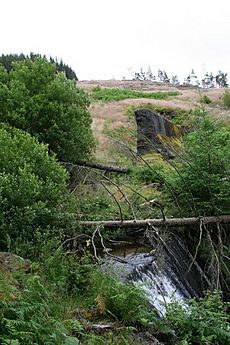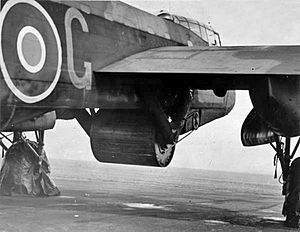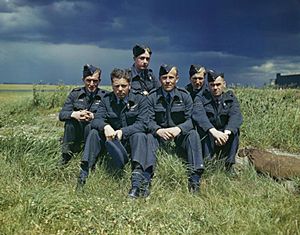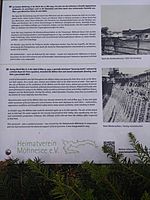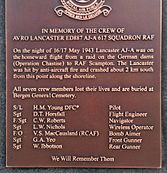Operation Chastise facts for kids
Quick facts for kids Operation Chastise |
|||||||
|---|---|---|---|---|---|---|---|
| Part of the Second World War | |||||||
 The Möhne dam the day following the attacks |
|||||||
|
|||||||
| Belligerents | |||||||
| Commanders and leaders | |||||||
| Strength | |||||||
| 19 Lancaster bombers | XII. Fliegerkorps (Defending three dams) |
||||||
| Casualties and losses | |||||||
| 8 aircraft lost 53 aircrew killed 3 aircrew taken prisoner. |
2 dams breached 1 dam lightly damaged c. 1,600 civilians killed (including c. 1,000 prisoners and slave labourers, mainly Soviet) |
||||||
Operation Chastise, often called the Dambusters Raid, was a daring attack on German dams during World War II. It happened on the night of May 16-17, 1943. A special group of pilots, 617 Squadron of the RAF Bomber Command, carried out the mission. They used unique "bouncing bombs" invented by Barnes Wallis.
The raid successfully broke two major dams: the Möhne and Edersee dams. This caused huge floods in the Ruhr and Eder valleys. Another dam, the Sorpe Dam, was only slightly damaged. The floods destroyed power stations, factories, and mines. Sadly, about 1,600 people died, including many forced laborers. Even though the Germans quickly repaired the dams, it took months for things to get back to normal. The RAF lost 8 aircraft and 53 aircrew members during the mission.
Why Attack the Dams?
Before World War II began, British military planners knew the industrial Ruhr Valley in Germany was very important. Its dams were key targets. These dams provided hydroelectric power (electricity from water) and clean water for making steel. They also supplied drinking water and water for the canal system, which was used for transport.
Attacking these dams with large bombs could cause a lot of damage. However, it was very hard to hit such well-protected targets accurately. The Royal Air Force (RAF) needed a special weapon for this job.
The Idea Behind the Bouncing Bomb
The idea for the special bomb came from Barnes Wallis, a brilliant designer at Vickers-Armstrongs. He had worked on bombers like the Vickers Wellington. Wallis first thought about a huge bomb dropped from very high up. But no plane could fly that high or carry such a heavy bomb.
Wallis then realized a smaller bomb could work if it exploded underwater, right against the dam wall. The problem was that German dams had strong torpedo nets to stop anything from reaching the wall underwater.
Wallis came up with a clever solution: a 9,000-pound (about 4,080 kg) cylindrical bomb, like a giant depth charge. This bomb was designed to spin backwards at 500 revolutions per minute (rpm). When dropped from 60 feet (18 meters) high at 240 mph (386 km/h), it would skip across the water's surface. This skipping would allow it to jump over the torpedo nets. Once it hit the dam, the backspin would make it roll down the dam wall underwater. It would then explode at the base, causing maximum damage. This secret weapon was called Upkeep.
Tests were crucial for this new idea. They blew up a small model dam in May 1942. Then, in July, they successfully breached an old dam in Wales called Nant-y-Gro. These tests showed that a 7,500-pound (about 3,400 kg) charge exploding 30 feet (9 meters) underwater could break a full-size dam. This weight was light enough for an Avro Lancaster bomber to carry.
The first air-drop tests happened in December 1942 at Chesil Beach. They used a spinning sphere dropped from a modified Vickers Wellington plane. These tests continued, helping to improve the bomb's design and how it was dropped.
Avro's chief designer, Roy Chadwick, modified the famous Lancaster bomber to carry the Upkeep mine. To make the plane lighter, some internal armor and the middle gun turret were removed. The bomb was so big and oddly shaped that the bomb-bay doors had to be taken off. The mine hung partly below the plane's body. It was held by two special supports and spun by an extra motor before being dropped. These specially modified Lancasters were called Lancaster B Mark III Special (Type 464 Provisioning).
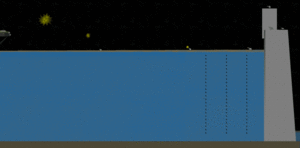
At first, some high-ranking officials, like Air Vice-Marshal Francis John Linnell, were worried this project was taking too much time away from other important aircraft designs. Even Arthur Harris, the head of Bomber Command, didn't want to give up his Lancasters for this mission. But Barnes Wallis wrote to an important intelligence officer, who made sure the Chief of the Air Staff, Air Chief Marshal Charles Portal, heard about the project. Portal saw the test films and was convinced.
On February 26, 1943, Portal overruled Harris. He ordered that thirty Lancasters be given for the mission. The target date was set for May, when the dams would be full, causing the most damage if breached. With only eight weeks to go, the larger Upkeep mine and the plane modifications still needed to be finished.
Choosing the Crews and Targets

The mission was given to No. 5 Group RAF, which created a new squadron just for this job. It was first called Squadron X. The leader was 24-year-old Wing Commander Guy Gibson, who had flown over 170 missions. Twenty-one bomber crews were chosen from other squadrons in 5 Group. These crews included airmen from the UK, Australia, Canada, and New Zealand. The squadron was based at RAF Scampton near Lincoln.
The main targets were the Möhne Dam and the Sorpe Dam, which were important for the Ruhr industrial area. The Eder Dam was a backup target. Breaking these dams would cut off hydroelectric power and water for industries, cities, and canals. It also had the potential to cause massive floods.
Getting Ready for the Mission
Dropping the bomb accurately meant flying at exactly 60 feet (18 meters) high and 240 mph (386 km/h) at a set distance from the target. This required highly skilled crews and intense training, especially at night and at very low altitudes.
There were also technical challenges. One was knowing the exact distance from the target. For the Möhne and Eder Dams, which had towers at each end, a special device with two prongs was used. When the prongs lined up with the towers, the plane was at the correct distance to release the bomb. (Some sources say a simpler method, like a loop of string, was also used due to vibration issues).
The second problem was knowing the plane's exact height, as normal altimeters weren't accurate enough at such low levels. Two spotlights were fitted to the plane, one under the nose and one under the fuselage. When the plane was at the correct height, the two light beams would meet in a single spot on the water's surface.
The crews practiced at several reservoirs, including Eyebrook Reservoir, Abberton Reservoir, and Derwent Reservoir. The squadron received the actual bombs on May 13, after final tests on April 29. On May 15, Gibson and Wallis briefed the squadron's flight commanders and bombing leader. The rest of the crews were told about the mission the next day.
How the Squadron Was Organized
The mission was split into three groups:
- Formation No. 1: Nine aircraft, led by Gibson, were to attack the Möhne Dam first. If they had bombs left, they would then attack the Eder Dam.
- Formation No. 2: Five aircraft, led by Flt Lt Joe McCarthy, were assigned to attack the Sorpe Dam.
- Formation No. 3: This was a reserve group of five aircraft. They would take off two hours later to bomb the main dams if needed, or attack smaller backup targets like the Lister, Ennepe, and Diemel dams.
Two crews couldn't fly due to illness. The mission's control center was at 5 Group Headquarters in St Vincents Hall, Grantham.
The Attacks Begin
Flying Out to Germany
The planes flew using two different routes, carefully avoiding areas with strong anti-aircraft guns (flak). They were timed to cross the enemy coast at the same moment. The first planes, from Formation No. 2, took off at 9:28 PM on May 16. McCarthy's plane had a problem, so he took off in a reserve aircraft 34 minutes late.
Formation No. 1 took off in groups of three, 10 minutes apart, starting at 9:39 PM. The reserve formation didn't start taking off until 12:09 AM on May 17.
The planes flew very low, at about 100 feet (30 meters) altitude, to avoid being detected by radar. One radio operator was amazed to see his pilot flying along a forest's firebreak, below the treetops!
First Losses
The first planes were lost soon after reaching the Dutch coast. Formation No. 2 had a tough time: Munro's plane lost its radio to flak and turned back. Rice flew too low, hit the sea, and lost his bomb, but managed to return to base. Barlow's plane hit electricity pylons and crashed. Byers' plane was shot down by flak. Only McCarthy's delayed bomber made it through the Netherlands.
Formation No. 1 lost Astell's bomber when it hit high-voltage power lines near the German village of Marbeck and crashed.
Attacking the Möhne Dam
Formation No. 1 arrived over the Möhne lake. Gibson's plane (G for George) made the first bombing run. Hopgood's plane (M for Mother) went next but was hit by flak and crashed after its own bomb exploded. Gibson then bravely flew his plane across the dam again to draw the flak away from Martin's run. Martin (P for Popsie) bombed third, damaging his plane but making a successful attack.
Next, Young (A for Apple) made a successful run. After him, Maltby (J for Johnny) dropped his bomb, and finally, the dam was breached! With the Möhne Dam broken, Gibson, with Young, led Shannon, Maudslay, and Knight towards the Eder Dam.
Attacking the Eder Dam
The Eder Valley was covered in thick fog. The dam wasn't defended by anti-aircraft guns because the surrounding hills made an attack seem impossible. The approach was very difficult. Shannon's plane made six attempts before taking a break. Maudslay (Z for Zebra) then tried, but his bomb hit the top of the dam, severely damaging his plane.
Shannon made another run and successfully dropped his bomb. The last bomb from the formation, dropped by Knight's plane (N for Nut), finally breached the Eder Dam.
Attacks on the Sorpe and Other Dams
The Sorpe Dam was an earthen dam, much harder to break than the concrete Möhne and Eder dams. Only two Lancasters reached it: Joe McCarthy (in T for Tommy) and later Brown (F for Freddie). This attack was different: the 'Upkeep' bomb wasn't spun, and the planes approached along the length of the dam, not across the reservoir.
McCarthy's plane arrived at the Sorpe Dam at 12:15 AM. The approach was very tricky, flying over a church steeple. His bomb aimer, George Johnson, had to be incredibly precise. McCarthy made nine attempts before Johnson was satisfied. On the tenth run, the bomb was dropped. It exploded, but only blew off a section of the dam's crest; the main dam held.
Three reserve aircraft were sent to the Sorpe Dam. Burpee (S for Sugar) was shot down on the way. Brown (F for Freddie) reached the Sorpe Dam. In the thick fog, after seven attempts, Brown dropped incendiary devices to create fires that lifted the fog enough for an eighth, direct hit. The bomb cracked the dam, but it didn't breach. Anderson (Y for York) couldn't find the target due to fog. The remaining two bombers were sent to secondary targets. Ottley (C for Charlie) was shot down on the way to the Lister Dam. Townsend (O for Orange) eventually dropped his bomb at the Ennepe Dam, but it caused no harm.
There is some evidence that Townsend might have accidentally attacked the Bever Dam instead of the Ennepe Dam. Reports from German sources and Townsend's crew suggest this possibility, as the two dams are close and the fog was very thick.
The Flight Home
On the way back, flying low again, two more Lancasters were lost. Maudslay's damaged plane was hit by flak near Netterden. Young's plane (A for Apple) was hit by flak north of IJmuiden and crashed into the North Sea. Some German flak was aimed so low that shells were seen bouncing off the sea.
Eleven bombers landed back at Scampton starting at 3:11 AM. Gibson returned at 4:15 AM. The last survivor, Townsend's bomber, landed at 6:15 AM. It was delayed because one of its engines had to be shut down. Air Chief Marshal Harris was there to greet the last crew.
Planes and Their Fates
| Aircraft call sign | Commander | Target | Attacked target? | Hit target? | Breached target? | Returned? | Notes |
|---|---|---|---|---|---|---|---|
| First Wave | |||||||
| G George | Gibson | Möhne Dam | Yes | No | N/A | Yes | Raid leader. Bomb exploded short of dam. Used aircraft to draw anti-aircraft fire away from other crews. |
| M Mother | Hopgood | Yes | No | N/A | No | Hit by anti-aircraft fire outbound. Bomb bounced over dam. Shot down over the target while attacking. (P/O Fraser and P/O Burcher survived) | |
| P Peter (Popsie) | Martin | Yes | No | N/A | Yes | Bomb missed the target. | |
| A Apple | Young | Yes | Yes | Yes | No | Bomb hit dam and caused small breach. On the way home, Lancaster AJ-A was hit by anti-aircraft fire and crashed near Castricum aan Zee. All seven crew members died. | |
| J Johnny | Maltby | Yes | Yes | Yes | Yes | Bomb hit dam and caused a large breach. | |
| L Leather | Shannon | Eder Dam | Yes | Yes | No | Yes | Bomb hit target—no effect. |
| Z Zebra | Maudslay | Yes | No | N/A | No | Bomb overshot target and damaged the bomber, which was shot down over Germany while trying to return. | |
| N Nancy (Nan) | Knight | Yes | Yes | Yes | Yes | Bomb hit the dam and caused a large breach. | |
| B Baker | Astell | N/A | No | N/A | N/A | No | Crashed after hitting large power lines on the way out. |
| Second Wave | |||||||
| T Tommy | McCarthy | Sorpe Dam | Yes | Yes | No | Yes | Bomb hit the target – no clear effect. |
| E Easy | Barlow | N/A | No | N/A | N/A | No | Crashed after hitting power lines on the way out. |
| K King | Byers | No | N/A | N/A | No | Shot down over the Dutch coast on the way out. | |
| H Harry | Rice | No | N/A | N/A | Yes | Lost the bomb after clipping the sea on the way out. Returned without attacking. | |
| W Willie | Munro | No | N/A | N/A | Yes | Damaged by anti-aircraft fire over the Dutch coast. Returned without attacking. | |
| Third Wave | |||||||
| Y York | Anderson | Sorpe Dam | No | N/A | N/A | Yes | Could not find the target due to mist. Landed with an armed bomb. |
| F Freddy | Brown | Sorpe Dam | Yes | Yes | No | Yes | Bomb hit the target – no clear effect. |
| O Orange | Townsend | Ennepe or Bever Dam | Yes | Yes | No | Yes | Bomb hit the target – no clear effect. |
| S Sugar | Burpee | N/A | No | N/A | N/A | No | Shot down over the Netherlands on the way out. |
| C Charlie | Ottley | No | N/A | N/A | No | Shot down over Germany on the way out. Frederick Tees was the only survivor. | |
| Totals | 19 aircraft | 4 dams | 11 of 19 | 7 of 11 | 3 of 7 | 11 of 19 | 2 hit power lines outbound; 3 shot down outbound; 3 returned without attacking;
11 attacked; 1 shot down over target; 2 shot down homebound; 8 attacked target and returned. |
Assessing the Damage
The RAF wanted to know the damage as soon as possible. A photo-reconnaissance Spitfire plane, flown by Flying Officer Frank 'Jerry' Fray, took off early the next morning. He flew over the Ruhr River and saw the breached dams and the massive floods.
Jerry Fray described what he saw: "When I was about 150 miles from the Möhne Dam, I could see the industrial haze over the Ruhr area. What looked like a cloud to the east turned out to be the sun shining on the floodwaters. I looked down into the deep valley, which had been so peaceful. Now it was a wide, rushing river. The whole valley was covered in water, with only patches of high ground and the tops of trees and church steeples showing. I was amazed by how huge it was."
After the Raid
Out of the 133 aircrew who took part, 53 were killed, a casualty rate of almost 40 percent. Three aircrew from Hopgood's plane parachuted out, but one later died, and the others were captured. One crewman from Ottley's plane survived its crash.
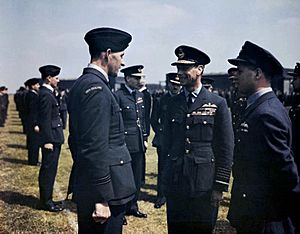
Many of the survivors were honored at Buckingham Palace on June 22. Guy Gibson received the highest award, the Victoria Cross. Other awards included Distinguished Service Orders, Distinguished Flying Crosses, and Distinguished Flying Medals.
Initial German estimates said 1,294 people were killed by the floods, including many French, Belgian, Dutch, and Ukrainian prisoners of war and laborers. Later estimates put the death toll in the Möhne Valley at about 1,600. The city of Neheim was hit hardest, with over 800 people dying there.
After the raid, 617 Squadron remained a special unit. They chose a motto, Après moi, le déluge ("After me the flood"). The squadron later used new, powerful bombs called Tallboy and Grand Slam bombs. They used these to attack important German targets, like the battleship Tirpitz, with much greater accuracy.
In 1977, a rule was added to the Geneva Conventions (Article 56 of Protocol I). It made it illegal to attack dams if it would cause severe harm to civilians. However, there's an exception if the dam is being used to directly support military operations and it's the only way to stop that support.
The last surviving member of the Dambusters, Johnny Johnson, passed away in 2022.
How the Raid Affected the War
Immediate Impact
The two direct hits on the Möhnesee dam created a breach about 250 feet (76 meters) wide and 292 feet (89 meters) deep. About 330 million tons of water flooded into the western Ruhr region. A torrent of water about 10 meters (33 feet) high, moving at 15 mph (24 km/h), swept through the valleys.
Some mines were flooded. Eleven small factories and 92 houses were destroyed, and many more were damaged. About 25 roads, railways, and bridges were washed away. Steel production in the Ruhr dropped significantly after the raid.
The Eder Dam's main purpose was to keep the Weser and Mittellandkanal rivers navigable. The flood wave from the Eder Dam was not strong enough to cause major damage by the time it reached Kassel, about 35 km (22 miles) downstream.
The biggest impact on German arms production was the loss of hydroelectric power. Two power stations were destroyed, and seven others were damaged. This caused a loss of electricity for factories and homes for two weeks. Coal production also dropped by 400,000 tons in May 1943 due to the raid.
German historian Ralf Blank states that at least 1,650 people were killed. Most of these were in the Möhne and Ruhr river areas, including over 1,000 foreign prisoners of war and forced laborers.
Longer-Term Effects
The Dambusters Raid helped the Allies by forcing Germany to use its resources for repairs instead of other war efforts. For example, the labor and materials used to fix the dams could not be used to build defenses like the Atlantic Wall.
The images of the broken dams were a huge boost for Allied morale, especially in Britain. The German population also saw the raids as a legitimate attack on military targets.
The raid also proved Barnes Wallis's ideas about "earthquake bombing" were effective. This led to the development of the Tallboy and Grand Slam weapons. These powerful bombs were used later in the war to destroy important German infrastructure, like V-2 rocket sites, V-3 cannons, bridges, and U-boat pens. They also helped sink the battleship Tirpitz.
Memorials
See also
- Attack on the Sui-ho Dam during the Korean War
- Dam failure
- Hydroelectric power station failures
- Operation Eisenhammer, a German plan to wreck critical Soviet hydroelectric turbines in World War II
- Operation Garlic, an attack by 617 Squadron on the Dortmund-Ems Canal
- Proposed bombing of Vietnam's dikes
- Noah Wolff
- Destruction of the Kakhovka Dam



